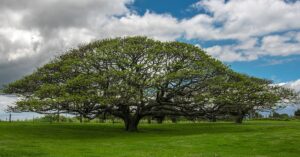Homeowners insurance is a critical safety net, protecting against various mishaps that can occur on your property. One common question among homeowners is whether their insurance policy covers the cost of preventative tree removal. This concern arises particularly when a tree poses a risk of falling and causing damage to the home or property. In this blog, we’ll provide a clear answer and explore the details of insurance coverage for preventative tree removal, tailored specifically for the US market.
The Short Answer
Generally, standard homeowners insurance policies do not cover the costs of preventative tree removal. This means that if a tree is healthy and there’s no immediate risk to your property, your insurance is unlikely to cover its removal. However, there are specific circumstances and particular endorsements that might allow for coverage, which we’ll discuss below.
Understanding the Coverage
Standard Homeowners Insurance Policy
Typical homeowners insurance policies provide coverage for tree removal only under certain conditions:
- Damage to Insured Structures: If a tree falls due to a covered peril and damages your house, garage, or fence, the costs to remove the tree usually are covered. The coverage generally includes removing the tree from the damaged structure and clearing it off your property.
- Blocked Driveway or Handicapped Accessibility: If a fallen tree blocks your driveway or a ramp designed for handicapped access, your policy may pay for its removal to ensure you can access your home.
The insurance industry defines covered perils as events like storms, lightning, fire, and vandalism, among others. It’s important to consult your policy to see which perils are covered.
Example Scenario
Imagine a large oak tree in your backyard has been struck by lightning and fallen onto your garage. This event is typically covered by homeowners insurance, and the costs for tree removal will be part of your claim.
Preventative Measures and Insurance
Preventative removal of trees to mitigate risk is usually considered a maintenance issue, which is the homeowner’s responsibility. Insurance does not cover these costs because the tree has not yet caused damage or created an emergency situation.
However, there are exceptions and extensions:
- Dead or Diseased Trees: If a tree is dead or diseased and poses an imminent risk to your property, some insurers may consider this when you apply for coverage. It’s essential to have a professional assessment to support your claim.
- Special Endorsements: You can sometimes add special endorsements to your policy for broader coverage, which might include the removal of trees that could pose a future threat to your property.
Policy Limitations and Additional Coverage
| Coverage Type | Description | Coverage Limit |
|---|---|---|
| Tree Removal after Damage | Cost of removing a tree that has fallen on a covered structure | Typically $500 – $1,000 per tree |
| Special Endorsements | Additional coverage for removing trees that may fall on a structure | Varies by policy and insurer |
Best Practices for Homeowners
- Regular Maintenance: Conduct regular inspections and maintenance of the trees on your property to prevent them from becoming hazards.
- Professional Consultation: Hire a certified arborist to assess the health and risk of the trees on your property.
- Insurance Review: Annually review your homeowners insurance policy and discuss with your insurance agent whether additional endorsements for tree removal are advisable.
When considering guidelines or references from the U.S. government regarding insurance coverage, particularly for something like preventative tree removal, there aren’t direct federal mandates that dictate whether insurance companies should cover this. However, there are some useful resources and general advice provided by government agencies that can help homeowners understand and manage the risks associated with trees on their property:
Federal Emergency Management Agency (FEMA)
FEMA often deals with the aftermath of natural disasters and provides guidelines on mitigating risks to property, including those related to falling trees. They offer resources on how to secure a property before a storm, which indirectly supports the practice of preventative tree removal. FEMA’s advice typically revolves around disaster preparedness rather than specific insurance coverage guidelines.
U.S. Forest Service
The U.S. Forest Service, part of the USDA, provides extensive information on tree care and urban forestry management. While not specifically aimed at insurance, their guidance can be invaluable in understanding how to maintain trees in a way that minimizes risks, potentially influencing insurance claims related to tree damage.
State Insurance Departments
Each state’s insurance department provides specifics on what homeowners insurance policies typically cover and what they don’t. These entities are the best resources for understanding state-specific regulations and standards regarding insurance. For instance, some states might have more detailed guidelines on insurance requirements in areas prone to specific natural disasters like hurricanes or wildfires, which can include stipulations about tree removal.
Useful Steps to Take:
- Review Local Regulations: Check with your city or county’s public works department for any local regulations or guidelines about tree removal. Some areas require permits or have specific conditions under which trees can be removed.
- Consult State Resources: Each state’s insurance commissioner’s website often has consumer resources explaining what homeowners insurance policies cover generally, and they might address common concerns like tree removal.
- Preventive Measures Documentation: If you’re considering removing a tree as a preventive measure, documenting the necessity (such as an arborist’s report) can be helpful if disputing coverage decisions with your insurance.
While these aren’t direct guidelines for insurance coverage, they can provide a framework for understanding and managing the risks associated with trees on your property, which in turn can impact your interactions with your insurance provider.
Concluding Thoughts
While homeowners insurance does not typically cover preventative tree removal, understanding the specifics of your policy and the options available can help you manage potential risks effectively. Regular maintenance and professional advice are your best tools in preventing unforeseen costs due to tree-related damages.
“Preventative tree removal is often seen as a homeowner’s responsibility, but understanding your insurance policy’s nuances can provide significant peace of mind,” says Jane Doe, an insurance expert. Always be proactive about your property’s needs and insurance coverage to ensure you’re fully protected.



